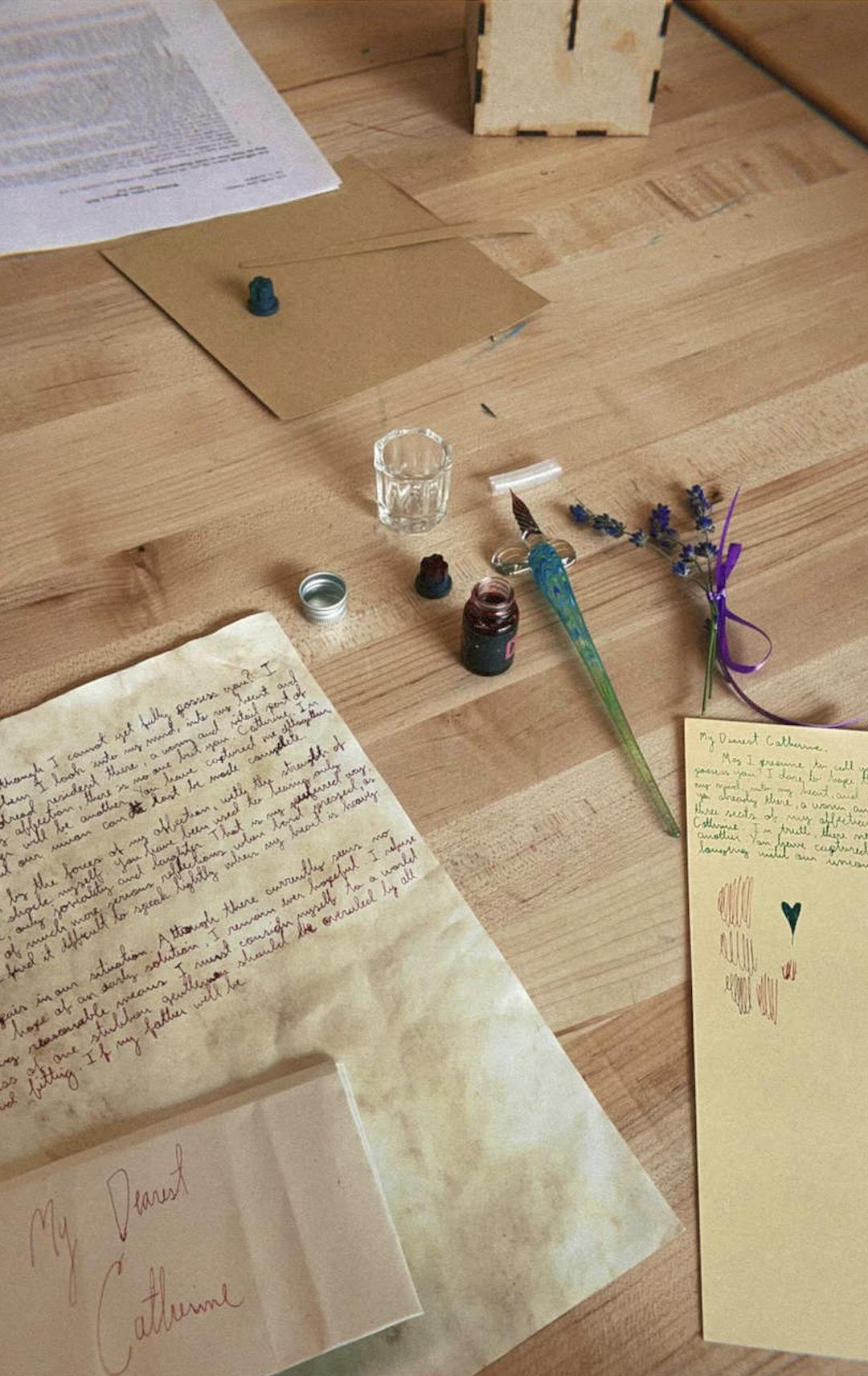Letters play a crucial role in the novels of Jane Austen. Using dip pens and ink, students in EN 354R on "Jane Austen" recreated some of the critical letters from Austen's memorable novels and fan fiction to gain insight into Austen's characters and to rekindle the writing practices of the Regency era. Tea-stained paper, crinkled paper, and parchment paper helped to make the letters authentic. Students learned to fold their letters and seal them, Regency style. Critical crafting brought Jane Austen's time to life.
Recreation of a Fan Fiction Love Letter from Henry Tilney to Catherine Morland of Northanger Abbey (1818), from Shannon Winslow's Murder at Northanger Abbey (2020), Crafted by Molly Jordan, 2023. Henry Tilney never actually writes Catherine Morland a letter, so Shannon Winslow crafts one in her fan fiction sequel to the novel. In this fan fiction, Catherine is married to Henry Tilney, who falls under suspicion of murder, and Catherine finds herself solving a real Gothic-style mystery to vindicate Henry. The letter is very effusive and in some ways seems out of character for Tilney, noted for his wit and more restrained charm. Would Austen's Henry Tilney really tell Catherine Morland, "You have captured me heart and soul"?
Students in EN 354R, "Jane Austen," in the Skidmore College IdeaLab Using Dip Pens and Ink to Recreate Letters from Austen's Novels, Photo by Catherine J. Golden, 2023. Students were engrossed in the practice of Regency letter writing. The concentration is palpable in the image. Students found it challenging to use dip pens without smudging and found it helpful to practice on scrap paper before creating their final versions of their letters on tea-stained paper.
Recreation of a Letter from Jane Bennet to her Sister Elizabeth, from Pride and Prejudice (1813), Crafted by Helen Horner, 2023. In a letter from Austen's Pride and Prejudice, Jane writes to her sister Elizabeth Bennet about the sudden coldness she is experiencing from the Bingley family, particularly from Caroline Bingley. She describes to Elizabeth how she did not see or hear from Caroline for a long time after calling upon her after arriving in London. Caroline finally returns the visit and is cold to Jane, who reasons that Caroline is avoiding her to discourage any communication between Jane and Bingley. This letter was recreated with ink and a glass dip pen on a regular sheet of white office paper that had been crinkled to give the letter a weathered appearance, as if it belonged to the Regency time period.
Arrangement of the Accoutrements of Writing, From the Personal Collection of Catherine J. Golden, Photo by Catherine J. Golden, 2023. These items, which date to the nineteenth century, demonstrate the lost art of letter writing. Moving clockwise, items include a papier-mâché desk set with glass ink wells holding two dip pens made of gold and ivory; a black metal blotter with gold floral decorations, which forms a set with a small black metal letter opener (included) and stamp box (popular post 1840 with the coming of the postage stamp, not shown); an additional dip pen in its original box with the owner's name written inside in ink; ink in black, navy, and gold; a lady's paper fan of the period.
Recreation of a Letter from William Collins to Mr. Bennet Announcing his Visit to Longbourn from Pride and Prejudice, Crafted by Bella Jevenson, 2023. Mr. Collins writes a letter to Mr. Bennet offering to heal the breach between his families in light of his future inheritance of Longbourn upon the death of Mr. Bennet. Writing with a dip pen proved challenging, and this student, who aimed for accuracy, composed part of the lengthy missive.
Arrangement of Two Missives, Lavender, and Folded Fan Fiction Love Letter from Henry Tilney to Catherine Morland of Northanger Abbey (1818), from Shannon Winslow's Murder at Northanger Abbey (2020), Crafted by Molly Jordan, 2023. This elegantly arranged image captures the process of letter creation. Two letters face open to show the care taken to write letters using different types of dip pens and different colors of ink. In addition, the folded letter addressed to Catherine Morland captures the way letters were sent prior to the coming of the Penny Post in 1840 to save costly postage since letters were charged according to the number of sheets used and the distance traveled. The sprig of lavender--which might aptly be called Regency Xanax--gives a touch of elegance to the composition and sets a calming mood.







